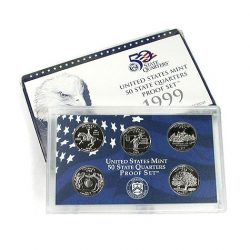Bring your Proof & Mint Sets Collection to the #1 Buyer in Las Vegas & Henderson
Sell your Proof and Mint Sets in Las Vegas because we PAY THE MOST and we buy ALL collections of Proof & Mint Sets.
Proof Sets History
Proof coins speak to the finest, the very best, that any U.S. Mint has to offer in terms of quality, care, and attention to detail when it comes to producing a coin.
Proof coins with a frosted image are called cameo proof coins. Cameo proofs, while exceedingly regular since the late 1970s are somewhat remarkable among proof coins from prior years.
Generally speaking, the greater part of proof coins struck since 1936 have brilliant, reflect like surfaces and moment points of interest struck in awesome lucidity.
The United States Mint has been making proof coins and proof sets since the nineteenth century. In any case, in 1936, the U.S. Mint started creating proof sets all the time and in more noteworthy numbers than the proof earlier of years.
Mint Sets History
Dissimilar to confirmation sets, most mint sets don’t contain coins that have been struck utilizing exceptional strategies for fabricate. Or maybe, mint sets generally contain coins of typical, mint-state quality.
Mint sets contain coins that are uncirculated and resemble straight from the Mint. However, they are not by any means any shinier or well-struck than normal, newly minted coins.
The advantage to buying mint sets over essentially removing coins from circulation is that mint set coins have never entered circulation, and in this manner are perfect and for all intents and virtually untouched. Mint set also sometimes contain coins that you would some way or not encounter in circulation.
The United States started creating mint sets in 1947.
With a few breaks underway amid the years (counting the noticeable nonappearance of mint sets amid 1982-1983), U.S. mint sets have experienced to a great extent 3 changes in set arrangement.
- Early mint coin sets were housed in cardboard containers and included 2 cases of each category and mint.
- Starting in 1959, the U.S. Mint exchanged its bundling organization with cellophane bundles, each striped with 2 splendidly shaded tape embeds on the best and base edges of these bundles. Blue demonstrates coins struck at the Philadelphia mint, and red shows coins struck at the Denver and San Francisco mints.
- Since 1999, the U.S. Mint has included white and dark strips to denote, respectively, Philadelphia and Denver bundles containing 50 state quarters.
Mint Coin Sets Become Popular Among Collectors
This point brings one to understand that, truth be told, mint sets now and again offered more to the collector than circulation coins ever could throughout the years.
5 popular cases in point
- 1970 mint set
- 1973 mint set
- 1981 mint set
- 1987 mint set
Differences between mint sets and proof sets:
- Proof sets contain one coin of every group and design and are carefully produced on polished coin blanks and are struck by cleaned passes on.
- Mint sets contain uncirculated coins close to the idea of routinely streaming coins. Mint sets contain one coin of each class and design made at each mint. subsequently, mint sets routinely contain no under 2 coins of each gathering.
- Proof sets made since the late 1960s are bundled in hard plastic cases.
- Mint sets made since the late 1950s contain no less than 2 independent, customarily cellophane-style packs. Every single mint set since the late 1950s bundles coins from Philadelphia in a blue-themed holder, though coins from Denver are housed in red-themed holders.
Related Categories:
To know the value of your Proof & Mint Sets, bring it into Nevada Coin Mart for a free verbal appraisal and evaluation today!











































